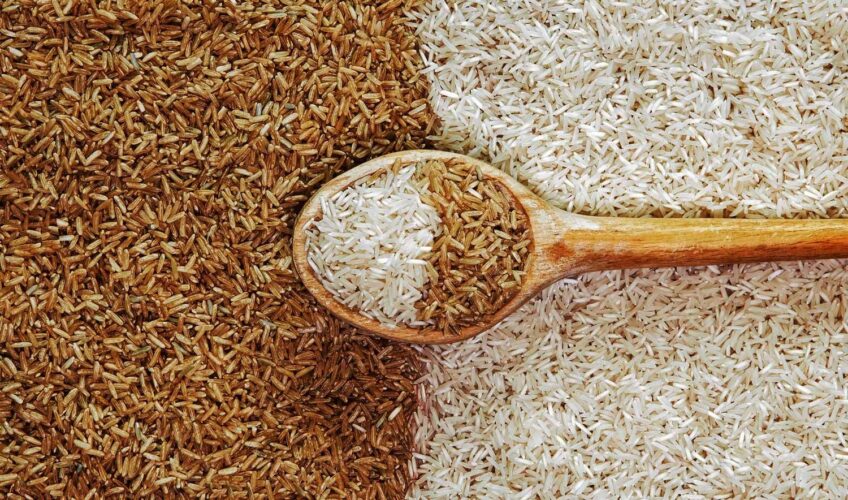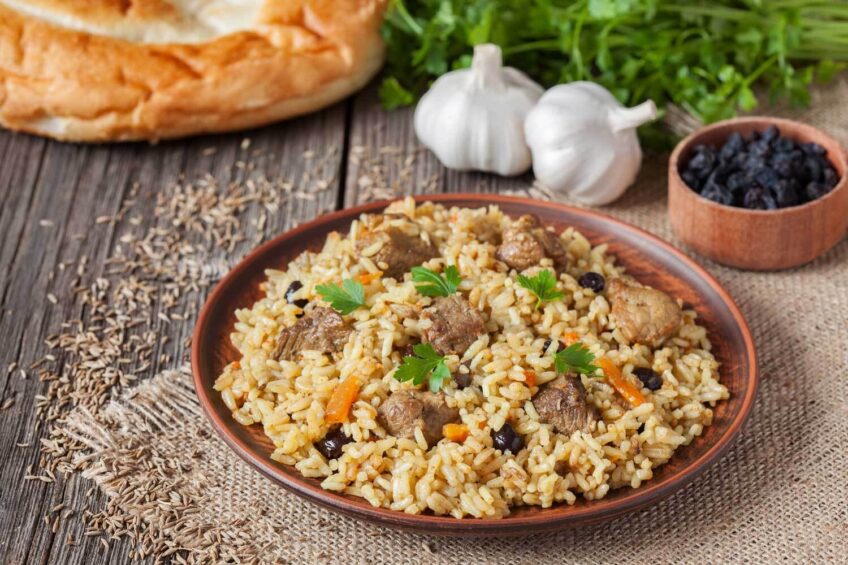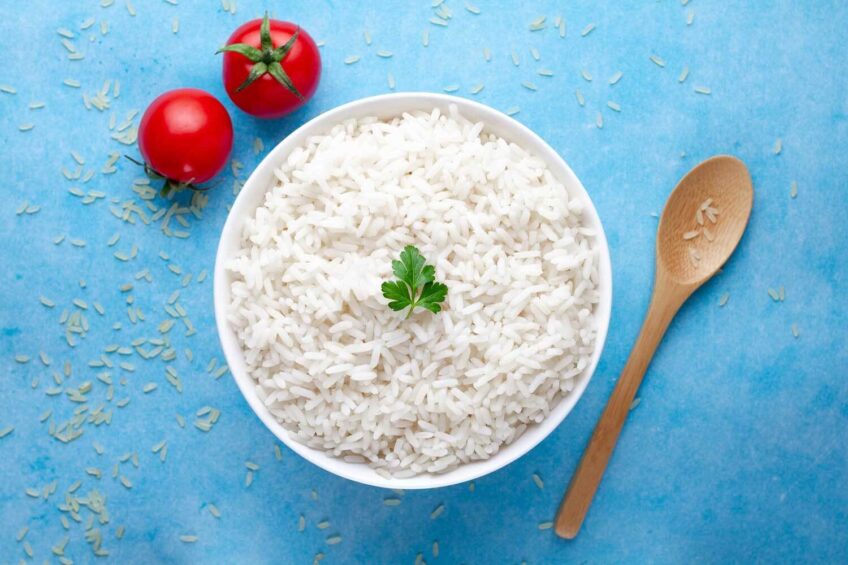Brown Rice vs White Rice, What’s the Difference?
Both types of rice have unique health benefits and different nutritional profiles.

I eat a lot of rice.
Rice is used as a staple food in many countries, and while traveling across Asia, Africa, and South America, I ate it almost daily.
In 2021 over 500 metric tons of rice were consumed across the world. And I probably consumed my fair proportion of that.
Whenever I am in a country where I consume a lot of white rice, I tend to gain weight. However, when I am able to cook my own food, I want to continue to eat things that I enjoy and have discovered on my adventures. So, I wanted to know whether it would be healthier to swap the white rice out for brown. The answer was more complicated than I imagined.
First, I didn’t realize that white and brown rice comes from the exact same grain! Rice is brown after harvesting and becomes white when an outer layer of bran is removed.
Red, black, and purple rice is also available across the world and is possible due to pigmentation in the bran. However, the most widely consumed rice is white, and brown rice is becoming increasingly popular in the West, as it is believed to be healthier.
Here I will explore this claim and what the differences are between the two most-eaten types of rice.
The Difference
All rice has a composition that is mostly carbs, with a small amount of protein and almost no fat.
One cup of brown rice contains about 53 grams of carbs, and a cup of white rice contains roughly 45 grams.
Brown rice is a whole grain, which means that it is all parts of the grain. This includes the nutritious germ, carb-rich endosperm, and fibrous bran. These provide fiber and essential vitamins and minerals such as magnesium, selenium, niacin, thiamine, phosphorus, niacin, vitamin B6, zinc, copper, and manganese.
On the other hand, white rice has had the germ and bran removed. These are the most nutritious parts of the grain. This leaves it with few nutrients, which is why brown is considered to be healthier.
Nutritional Content
Brown rice takes the prize when it comes to nutritional content. It has more antioxidants, fiber, minerals, and vitamins. In contrast, white rice is mostly empty calories with very few nutrients.

One cup of brown rice (195g) contains 3.5 grams of fiber, whereas a cup of white rice contains just 0.6 grams.
On the other hand, brown rice does contain slightly more calories. One cup of brown rice contains 216 calories, whereas a cup of white rice contains 205 calories. Both still contain 185 calories from carbohydrates, and white rice contains slightly fewer calories because of the nutritional things that are removed from it.
The table below is a comparison of vitamins and minerals contained in rice:
| White (RDI) | Brown (RDI) | |
| Thiamine | 1% | 6% |
| Manganese | 24% | 45% |
| Iron | 1% | 2% |
| Niacin | 2% | 8% |
| Zinc | 3% | 4% |
| Magnesium | 3% | 11% |
| Vitamin B6 | 5% | 7% |
| Phosphorus | 4% | 8% |
Benefits of Brown Rice
Brown rice has a lot of health benefits over white rice, including powerful vitamins and minerals, which can reduce blood pressure and decrease the risk of heart disease and cancer. Furthermore, brown rice is full of fiber, which can help weight management and energy levels.
Lignans
Brown rice contains lignans, which are a plant compound that has been found to protect against heart disease. One study found that people who eat a lot of whole grains like brown rice had up to 21% lower risk of heart disease.
Additionally, lignans can lower blood pressure, reduce fat in the blood, and decrease inflammation in the arteries. These are all risk factors for heart disease.
Lignans have also been found to reduce the risk of cancer by preventing cellular changes.
Antioxidants
The bran in brown rice, which is removed to make white rice, contains a lot of antioxidants. It also contains manganese, which helps with antioxidant function, as well as producing energy.
Antioxidants such as those found in whole grains can prevent cancer, type 2 diabetes, and cancer.
Fiber
Brown rice contains high amounts of fiber, which has many health benefits. It can help you feel full faster and longer, which can help weight management. One large study on nearly 30,000 adults showed that the more whole grains they ate, the lower their weight.
Fiber also lowers cholesterol, helps your gut bacteria, and lowers your risk of diabetes and heart disease.
Fiber and magnesium found in brown rice also help to control blood sugar levels. This decreases the risk of diabetes.
While white rice can increase the risk of type 2 diabetes, this is because it has a high glycemic index (GI), which means that it increases blood sugar. Unless you have diabetes, so long as you have a varied diet, this shouldn’t be a problem.
Selenium
Brown rice is an excellent source of selenium which helps thyroid function, protects antioxidants, and aids your immune system.
Additionally, it prevents neurological diseases like Alzheimer's, Parkinson's, and multiple sclerosis.
It also works alongside vitamin E to protect cells from becoming cancerous.
Magnesium
Magnesium is often a mineral that most people do not get enough of. However, just one cup of brown rice will provide you with 22% of your daily recommended magnesium, which helps with bone health, muscle contraction, cell production, and blood coagulation.
Furthermore, it may help you to perform better when you exercise and reduce inflammation. While also helping you to create and repair DNA and RNA.
The Downside to Brown Rice
Just when I was absolutely convinced to throw out all of my white rice in favor of brown rice, I found that there is a downside to brown rice.
It contains antinutrients that stop your body from absorbing all of those fantastic nutrients which we have been analyzing. It also contains higher levels of arsenic, which can be cancerous.

Antinutrients
Brown rice contains antinutrients called phytic acid or phytate, and these may prevent your body from absorbing certain nutrients.
In one study published in the National Library of Medicine, five young men were monitored after eating mainly brown rice for eight days and white rice for the other six days.
When eating brown rice, their fecal weight increased, and their digestion of protein, fat, and energy decreased, so did their absorption of Na, K, and P. Nitrogen was negative when eating either type of rice, but more so on brown, the phosphorus balance was also negative when eating brown rice. However, other minerals were not affected.
The study concluded that brown rice reduced nitrogen balance and protein digestibility.
Arsenic
Rice also contains trace amounts of arsenic, which is a carcinogen. Arsenic is naturally occurring on the earth and can also be increased by the use of pesticides. Trace amounts can be found in many of the foods we eat, but unfortunately, rice absorbs it more than other plants.
Brown rice usually contains more arsenic than white, and basmati white rice contains the least.
According to the USA Rice Federation, the benefits of including rice in your diet outweigh the risk of small amounts of arsenic. Furthermore, the levels of arsenic are not high enough to cause concern, or so they say.
So long as you are eating a varied diet, you shouldn’t have to worry. However, if you eat a lot of rice, then there are things you can do to reduce the amount of arsenic -- make sure to wash the rice thoroughly before cooking it and use plenty of water when you do cook it.
My Thoughts?
Both kinds of rice come with advantages and disadvantages. While both come from the exact same grain, white rice has had most of the nutrients removed from it. That being said, white rice has also had a lot of the antinutrients and arsenic removed from it in the process.
That being said, whole grains are an important part of your diet that are rich in nutrients and fiber. They reduce your risk of type 2 diabetes, heart disease, some forms of cancer, and obesity. Furthermore, they help your gut health and digestive system.
So long as you are eating a varied and healthy diet, which includes other whole grains such as oatmeal, whole wheat bread, and barley, your choice of rice does not have a huge impact. This is great news if you love white rice.
However, swapping your white rice out for brown is a great way to ensure that you are getting enough whole grains. And getting sufficient whole grains can be difficult. The American Dietetic Association suggests three servings daily!
Although brown rice contains antinutrients and more arsenic than white rice, when eaten as part of a balanced diet, these shouldn’t be harmful. Furthermore, the benefits of brown rice outweigh the risks. Brown rice lowers your blood sugar, decreases the risk of heart disease, and helps you to feel fuller for longer.
Of course, there are many other factors to consider, such as your weight and fitness goals and how rice "carbs" contributes to your overall macros.
For me, brown rice tends to win. Where possible, I will still be swapping out my white rice for brown...unless I'm eating sushi.
Tony Lee, MS, RD
Tony Lee, RD, MS, is a highly qualified and accomplished Registered Dietitian with a Master’s Degree in Nutrition Sciences. Tony brings over two decades of experience in dietetics, specializing in sports nutrition. Interests include studying all aspects of wellness, fitness, genetics, and peak health performance.










